How to back up files from Mac to Synology NAS with Time Machine

Overview
This article will guide you through the process of backing up data from your Mac OS X computer to a Synology DiskStation using Apple’s Time Machine, a backup utility included in Mac OS X 10.5 and later.
Contents
- Set up DiskStation to support Time Machine
- Perform Time Machine Backup to DiskStation
- More Information
1. Set up DiskStation to support Time Machine
Before setting your DiskStation as the destination for Time Machine, you’ll need to login to DSM and change a few settings.
1.1 Create a shared folder for Time Machine backup
- Login to DSM with an account belonging to the administrators group.
- Go to Control Panel > Shared Folder and click Create to create a shared folder.

- Enter a name for the shared folder (such as “Time Machine Folder”) and select a location (if multiple volumes exist). In this example, we’ll choose Volume 1.
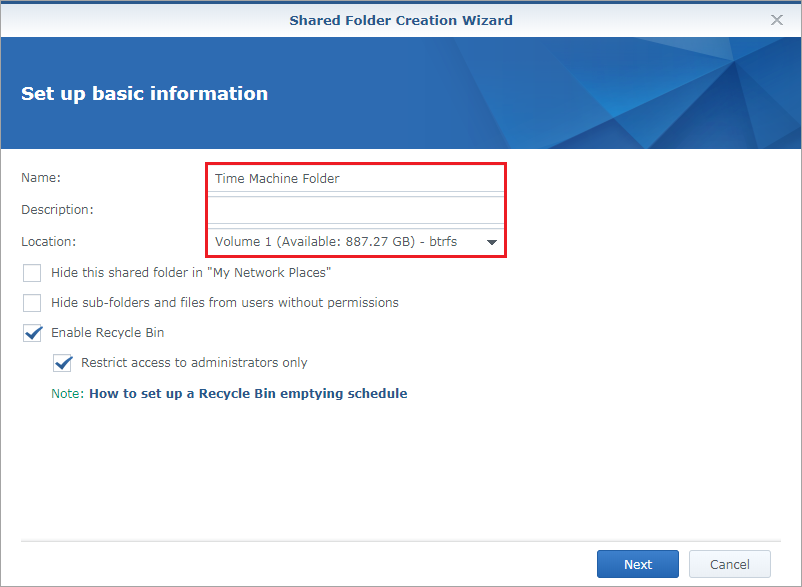
- Check the Encrypt this shared folder box and enter an encryption key if you would like to encrypt the shared folder Time Machine Folder, and then click Next.

- Configure advanced settings for the shared folder as you prefer, and then click Next.

- Click Apply.

- Click OK.

- Now you should see the newly-created shared folder.
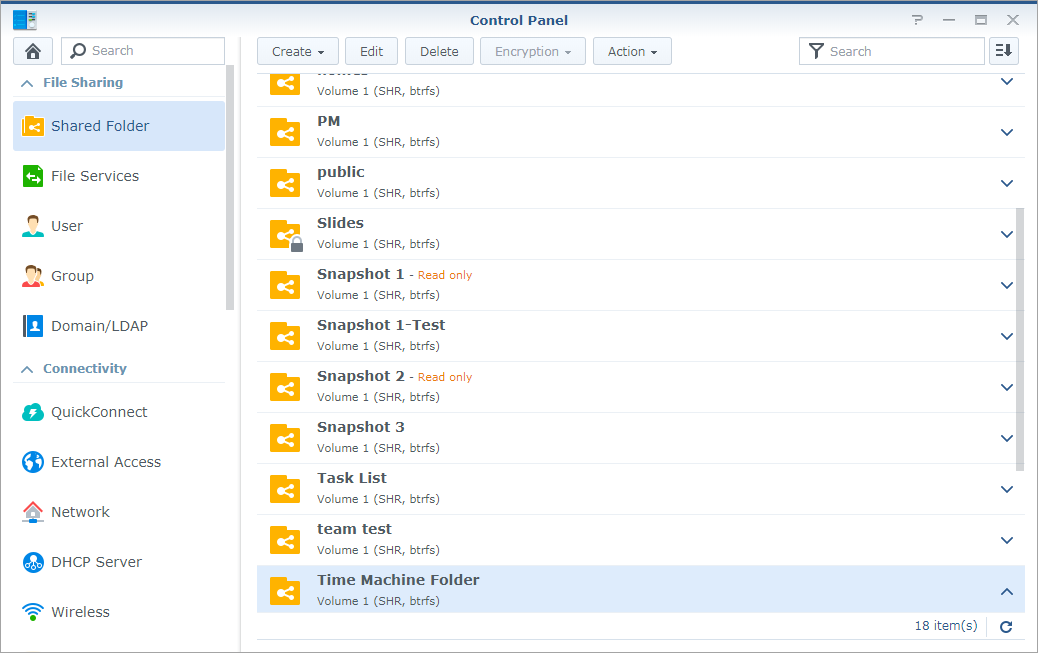
1.2 Create a user for Time Machine and set quota limit
-
- Go to Control Panel > User and click Create.

- Enter a username (such as “Time Machine User”) and specify a password. Then click Next.

- Click Next.

- Make sure this user is assigned read/write permission to Time Machine Folder, and click OK.

- In this example, we’ll back up data to Time Machine Folder. However, we don’t want the backup to use up your space, so we’ll specify a usage quota. On the User quota setting page, enter a value you prefer in the Quota field and select a Unit from the drop-down menu. For example, we’ll set a quota of 200 GB for Time Machine Folder. After specifying a quota, click Next.

- Go to Control Panel > User and click Create.
Note:
- We recommended you set a quota to prevent Time Machine from occupying your entire storage space. In general, the quota should be at least two or three times the size of your Mac’s hard drive or the amount of data to be backed up.
- Only on models that support the Btrfs file system can users set usage quotas for individual folders. If your NAS server only supports the EXT4 system, you can only set a usage quota for the entire volume.
- Click Next.

- Click Next.

- Click Apply.

- Now we should have a user called Time Machine User.

1.3 Set the shared folder as Time Machine’s backup target
-
- Go to Control Panel > File Services.

- Find the AFP section on the SMB/AFP/NFS tab, and check the Enable AFP service box.
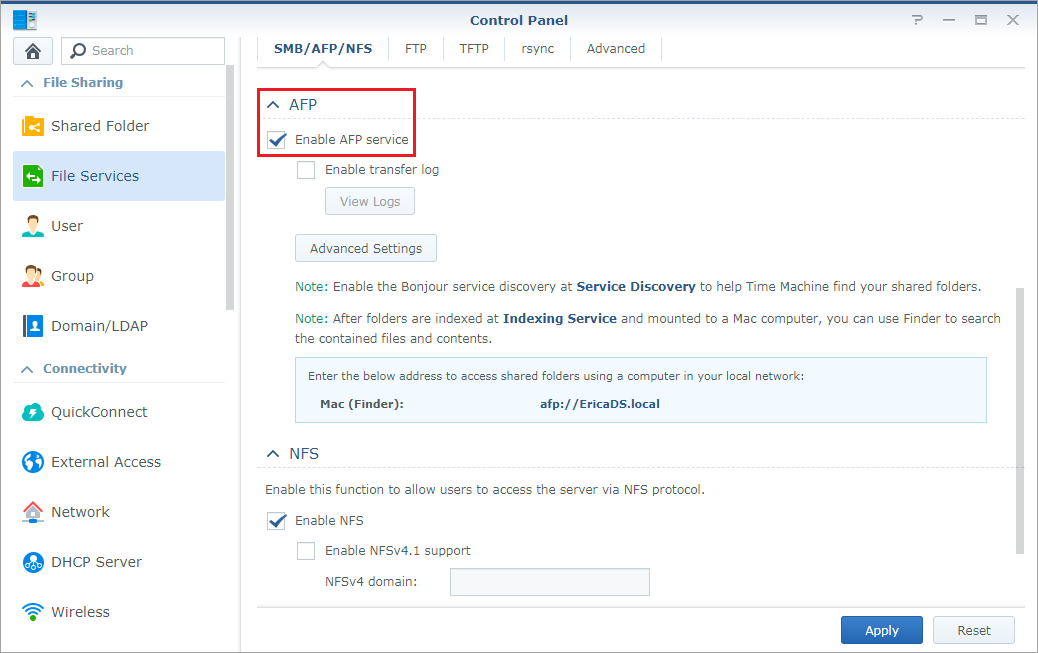
- Go to Control Panel > File Services.
Note:
- Time Machine supports both SMB and AFP. For macOS Sierra and later, Time Machine uses SMB, instead of AFP, as the default protocol.
- If you want to back up your files via SMB, please go to the SMB section on the same tab, and check the Enable SMB service box.
-
- Go to the Advanced tab, check the Enable Bonjour Time Machine broadcast via AFP box, and click on the Set Time Machine Folders button.

- Choose the shared folder you just created from the Time Machine menu, and click Apply to save settings.

- Go to the Advanced tab, check the Enable Bonjour Time Machine broadcast via AFP box, and click on the Set Time Machine Folders button.
Note: If you chose to use SMB in the step 1.3.2, please check the Enable Bonjour Time Machine broadcast via SMB box instead. Choose the shared folder you just created and click Apply. Then click Yes in the popup window to confirm and save your settings.
2. Perform Time Machine Backup to DiskStation
This section will show you how to configure Time Machine to set DiskStation’s shared folder as the backup destination. This process allows Time Machine to easily locate your DiskStation on the local area network and regard it as the backup disk. When the setup is complete, Time Machine will be able to start backing up data to the DiskStation.
2.1 Connect to your NAS server
- On your Mac, click Go in the top menu bar, and select Connect to Server.

- Enter the address of your NAS server. Use AFP or SMB according to your setting in the step 1.3.2. After specifying the address, click Connect.

- Enter your account credentials, and click Connect.

- Select Time Machine Folder from the list, and then click OK.

2.2 Configure Time Machine to set DiskStation as its backup disk
- On your Mac, open System Preferences from the Dock, and click Time Machine.
- Check the Back Up Automatically box, and click Select Disk.
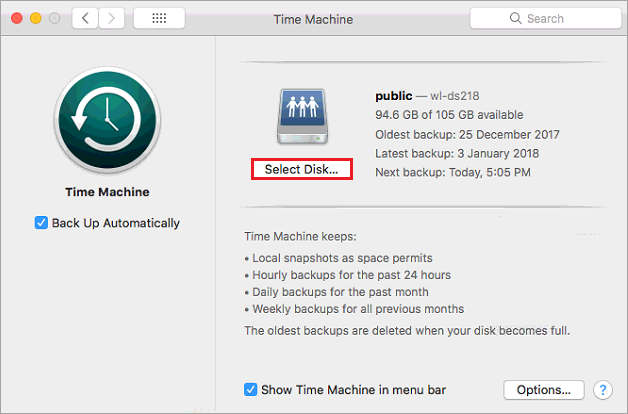
- Choose the shared folder you created, which is Time Machine Folder in this case, and then click Use Disk.
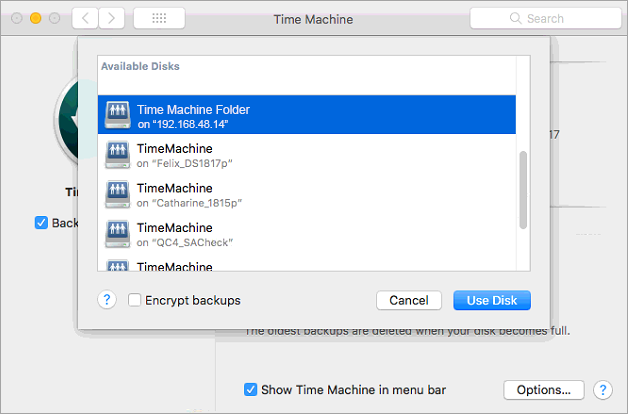
- The system will prompt you to provide your account credentials. Enter the username and password of the user you just created, and click Connect.

- Time Machine will start backing up data soon after.
| Where to Buy a Product | |||
|
|
    
|

|
VISIT RETAILER ➤ |
 |
    
|

|
VISIT RETAILER ➤ |
 |
    
|

|
VISIT RETAILER ➤ |
 |
    
|

|
VISIT RETAILER ➤ |
If you like this service, please consider supporting us.
We use affiliate links on the blog allowing NAScompares information and advice service to be free of charge to you. Anything you purchase on the day you click on our links will generate a small commission which is used to run the website. Here is a link for Amazon and B&H. You can also get me a ☕ Ko-fi or old school Paypal. Thanks! To find out more about how to support this advice service check HERE
We use affiliate links on the blog allowing NAScompares information and advice service to be free of charge to you. Anything you purchase on the day you click on our links will generate a small commission which is used to run the website. Here is a link for Amazon and B&H. You can also get me a ☕ Ko-fi or old school Paypal. Thanks! To find out more about how to support this advice service check HERE
Private 🔒 Inner Circle content in last few days :
Beelink ME Pro NAS Revealed
Best SOLID STORAGE NAS of 2025
Should You Worry About the NanoKVM Hidden Microphone?
Best Cheap NAS of 2025
Minisforum MS-02 Ultra - WHO IS THIS FOR??? (The First 48HRs)
Why People Use TrueNAS, UnRAID and Proxmox to Turnkey NAS (Synology, QNAP, etc)
Access content via Patreon or KO-FI
Beelink ME Pro NAS Revealed
Best SOLID STORAGE NAS of 2025
Should You Worry About the NanoKVM Hidden Microphone?
Best Cheap NAS of 2025
Minisforum MS-02 Ultra - WHO IS THIS FOR??? (The First 48HRs)
Why People Use TrueNAS, UnRAID and Proxmox to Turnkey NAS (Synology, QNAP, etc)
Access content via Patreon or KO-FI
Discover more from NAS Compares
Subscribe to get the latest posts sent to your email.





DISCUSS with others your opinion about this subject.
ASK questions to NAS community
SHARE more details what you have found on this subject
IMPROVE this niche ecosystem, let us know what to change/fix on this site